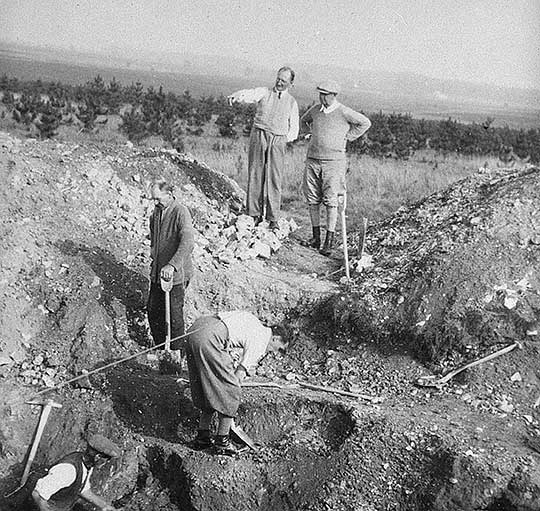Research on Grime’s Graves
Both antiquarian activity and modern research have helped to build an understanding of this (currently) unique late Neolithic flint mine. A number of research questions remain to be answered, however, mainly about the life of the miners, and the distribution of the tools that were made at Grime's Graves.

Early Excavations
The earliest known excavations occurred in 1852, when the Revds ST Pettigrew and CR Manning dug several pits. In 1866 Manning returned and excavated others, but these 'diggings' mistakenly excavated only the upper fills of the shafts and halted at the first evidence of hearths. The shafts were consequently misinterpreted as Iron Age sunken huts.
This hypothesis was overturned by Canon William Greenwell in 1868–70, when he proved for the first time the existence anywhere in the UK of Neolithic deep-shaft mining.[1]
Excavations resumed in 1914, when the Prehistoric Society of East Anglia excavated Pits 1 and 2 to test the then recently proposed theory that flint mining was Palaeolithic in origin. However, little evidence was found to support this idea.[2]
During the interwar years many excavations took place, particularly those by AL (Leslie) Armstrong,[3] which culminated in the excavation of Pit 15 in 1939 and the discovery of a chalk 'goddess' at the base of the shaft.[4] Since this appeared to echo the style of Palaeolithic carvings, it could be seen to support a Palaeolithic date for the mines. However, the weight of evidence by this time pointed to a Neolithic date, and it seems most likely from the context of the discovery that the 'goddess' was actually a forgery.
Later Investigations
The most recent major excavations at Grime's Graves were those in the 1970s carried out by Roger Mercer (under the auspices of the Department of the Environment),[5] and the British Museum.[6]
The Mercer project provided much useful information on the structure and content of two shafts, and a particularly detailed analysis of the stone tools and the by-products of how they were made.
The British Museum project reopened Greenwell's Pit and others, recorded their structures and provided useful insights into the mining process. It also usefully assessed the assemblages from new and previous excavations.
In the 21st century two ground-penetrating radar projects have produced much new information about the scale and extent of mining activity on site.[7] A doctoral thesis by Barry Bishop at the University of York[8] has further explored the environs of the site and demonstrated that much new evidence lies beyond the limits of the earthworks.
Gaps in Current Knowledge
- The detail of the environmental context of flint mining is poorly understood, and currently relies upon outdated evidence or samples taken from shaft fills. This may have produced a biased result that does not reflect the wider landscape setting.
- There is currently little evidence of the location or nature of the form of settlement or temporary camp inhabited by the Neolithic miners, either among the earthworks or on their periphery.
- Little is known about the miners, their origin or their lifestyle.
- The lack of precision in sourcing flint tools makes it difficult to identify with any real precision the extent of the distribution patterns of flint tools originating from Grime's Graves, or indeed any of the other flint mines.
- The recent identification of evidence for early Bronze Age mining[9] requires further study to determine its nature and extent across the site, and whether it also occurred at the early Neolithic mines on the South Downs.
READ MORE ABOUT GRIME'S GRAVES
Footnotes
1. W Greenwell, 'On the opening of Grime's Graves in Norfolk', Journal of the Ethnological Society of London, new series, 2 (1870), 419–39 (accessed 1 Sept 2015).
2. WG Clarke, Report on the Excavations at Grime's Graves, Weeting, Norfolk, March–May 1914 (London, 1915).
3. Publications by AL Armstrong in the Proceedings of the Prehistoric Society of East Anglia include: 'Flint-crust engravings, and associated implements from Grime's Graves, Norfolk', 3 (1921), 434–43; 'The Grime's Graves problem in the light of recent research', 5 (1927), 91–136; 'The Percy Sladen Trust excavations, Grime's Graves, Norfolk: interim report, 1927–1932', 7 (1934), 57–61; and 'Grime's Graves, Norfolk: report on the excavation of Pit 12', 7 (1934), 382–94.
4. I Longworth, A Herne, G Varndell and S Needham, Excavations at Grimes Graves, Norfolk, 1972–1976, Fascicule 3: Shaft X: Bronze Age Flint, Chalk and Metal Working (London, 1991); I Longworth and G Varndell, Excavations at Grimes Graves, Norfolk, 1972–1976, Fascicule 5: Mining in the Deeper Mines (London, 1996).
5. RJ Mercer, Grimes Graves, Norfolk: Excavations 1971–72, volume 1 (London, 1981).
6. J Clutton-Brock, Excavations at Grimes Graves, Norfolk, 1972–1976, Fascicule 1: Neolithic Antler Picks from Grimes Graves, Norfolk, and Durrington Walls, Wiltshire: a Biometrical Analysis (London, 1984); AJ Legge, Excavations at Grimes Graves, Norfolk, 1972–1976, Fascicule 4: Animals, Environment and the Bronze Age Economy (London, 1992); I Longworth, A Ellison and V Rigby, Excavations at Grimes Graves, Norfolk, 1972–1976, Fascicule 2: The Neolithic, Bronze Age and Later Pottery (London, 1988); Longworth et al, op cit; Longworth and Varndell, op cit; I Longworth, G Varndell and J Lech, Excavations at Grimes Graves, Norfolk, 1972–1976, Fascicule 6: Exploration and Excavation Beyond the Deep Mines (London, 2012).
7. NT Linford, L Martin and J Holmes, Grime's Graves, Norfolk: Report on Geophysical Survey, November 2007, English Heritage Research Report 64/2009 (Swindon, 2009) (accessed 1 Sept 2015).
8. B Bishop, 'Grimes Graves environs survey', PhD thesis, University of York, Department of Archaeology (2013).
9. F Healy et al, Grime's Graves, Weeting-with-Broomhill, Norfolk: Radiocarbon Dating and Chronological Modelling, English Heritage Research Report 27/2014 (Swindon, 2014) (accessed 18 Aug 2016).
